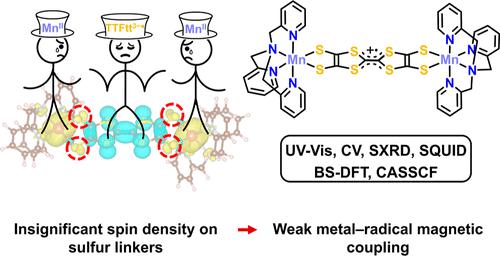当前位置:
X-MOL 学术
›
Inorg. Chem.
›
论文详情
Our official English website, www.x-mol.net, welcomes your
feedback! (Note: you will need to create a separate account there.)
Origin of Weak Magnetic Coupling in a Dimanganese(II) Complex Bridged by the Tetrathiafulvalene-Tetrathiolate Radical
Inorganic Chemistry ( IF 4.3 ) Pub Date : 2023-11-15 , DOI: 10.1021/acs.inorgchem.3c02534
Chen-Yu Lien 1 , Jan-Niklas Boyn 2 , Sophie W Anferov 1 , David A Mazziotti 1 , John S Anderson 1
Inorganic Chemistry ( IF 4.3 ) Pub Date : 2023-11-15 , DOI: 10.1021/acs.inorgchem.3c02534
Chen-Yu Lien 1 , Jan-Niklas Boyn 2 , Sophie W Anferov 1 , David A Mazziotti 1 , John S Anderson 1
Affiliation

|
Magnetic exchange coupling (J) between different spin centers plays a crucial role in molecule-based magnetic materials. Direct exchange coupling between an organic radical and a metal is frequently stronger than superexchange through diamagnetic ligands, and the strategy of using organic radicals to engender desirable magnetic properties has been an area of active investigation. Despite significant advances and exciting bulk properties, the magnitude of J for radical linkers bridging paramagnetic centers is still difficult to rationally predict. It is thus important to elucidate the features of organic radicals that govern this parameter. Here, we measure J for the tetrathiafulvalene-tetrathiolate radical (TTFtt3–•) in a dinuclear Mn(II) complex. Magnetometry studies show that the antiferromagnetic coupling in this complex is much weaker than that in related Mn(II)–radical compounds, in contrast to what might be expected for the S-based chelating donor atoms of TTFtt. Experimental and computational analyses suggest that this small J coupling may be attributed to poor overlap between Mn- and TTFtt-based magnetic orbitals coupled with insignificant spin density on the coordinating S-atoms. These factors override any expected increase in J from the comparatively strong S-donors. This work elucidates the magnetic coupling properties of the TTFtt3–• radical for the first time and also demonstrates how multiple competing factors must be considered in rationally designing organic radical ligands for molecular-based magnetic compounds.
中文翻译:

由四硫富瓦烯-四硫醇自由基桥联的二锰(II)配合物中弱磁耦合的起源
不同自旋中心之间的磁交换耦合( J )在分子磁性材料中起着至关重要的作用。有机自由基和金属之间的直接交换耦合通常比通过抗磁性配体的超交换更强,并且使用有机自由基产生所需磁性的策略一直是积极研究的领域。尽管取得了重大进展并具有令人兴奋的整体特性,但桥接顺磁中心的自由基连接体的J的大小仍然难以合理预测。因此,阐明控制该参数的有机自由基的特征非常重要。在这里,我们测量双核 Mn(II) 络合物中四硫富瓦烯-四硫醇盐自由基 (TTFtt 3–• ) 的J。磁力测量研究表明,该配合物中的反铁磁耦合比相关 Mn(II) 自由基化合物中的反铁磁耦合弱得多,这与 TTFtt 的 S 基螯合供体原子的预期相反。实验和计算分析表明,这种小J耦合可能归因于 Mn 和 TTFtt 基磁轨道之间的重叠不良,以及配位 S 原子上的自旋密度不显着。这些因素压倒了相对较强的 S 捐助者对J的任何预期增加。这项工作首次阐明了 TTFtt 3–•自由基的磁耦合特性,并证明了在合理设计基于分子的磁性化合物的有机自由基配体时必须考虑多种竞争因素。
更新日期:2023-11-15
中文翻译:

由四硫富瓦烯-四硫醇自由基桥联的二锰(II)配合物中弱磁耦合的起源
不同自旋中心之间的磁交换耦合( J )在分子磁性材料中起着至关重要的作用。有机自由基和金属之间的直接交换耦合通常比通过抗磁性配体的超交换更强,并且使用有机自由基产生所需磁性的策略一直是积极研究的领域。尽管取得了重大进展并具有令人兴奋的整体特性,但桥接顺磁中心的自由基连接体的J的大小仍然难以合理预测。因此,阐明控制该参数的有机自由基的特征非常重要。在这里,我们测量双核 Mn(II) 络合物中四硫富瓦烯-四硫醇盐自由基 (TTFtt 3–• ) 的J。磁力测量研究表明,该配合物中的反铁磁耦合比相关 Mn(II) 自由基化合物中的反铁磁耦合弱得多,这与 TTFtt 的 S 基螯合供体原子的预期相反。实验和计算分析表明,这种小J耦合可能归因于 Mn 和 TTFtt 基磁轨道之间的重叠不良,以及配位 S 原子上的自旋密度不显着。这些因素压倒了相对较强的 S 捐助者对J的任何预期增加。这项工作首次阐明了 TTFtt 3–•自由基的磁耦合特性,并证明了在合理设计基于分子的磁性化合物的有机自由基配体时必须考虑多种竞争因素。































 京公网安备 11010802027423号
京公网安备 11010802027423号